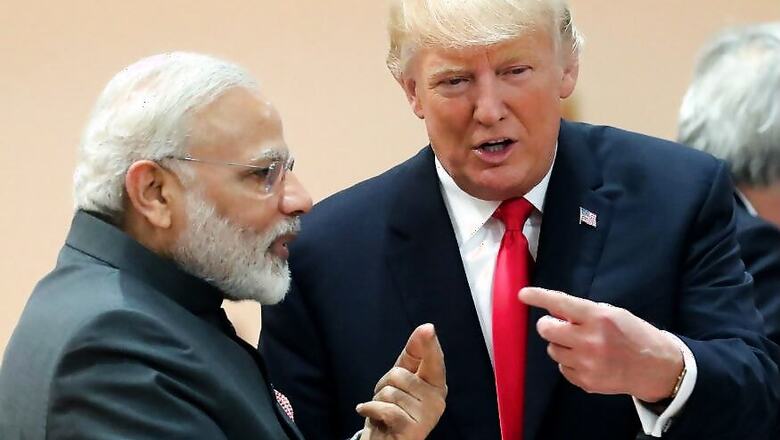
views
Trade and tariff issues have emerged as an irritant in the India-US relationship over the last couple of years. US President Donald Trump’s tweets, making the friction public, have only resulted in this one issue overshadowing all other aspects of the bilateral relations. As Commerce and Industry Minister Piyush Goyal gears up to visit US in August end to iron out the differences, experts believe that despite the challenges the issue is “manageable".
Just ahead of the USTR team's visit to India to engage on outstanding trade issues, President Trump tweeted, "India has long had a field day putting tariffs on American products. No longer acceptable!"
His tweet was perceived as a pressure-building exercise ahead of the talks. However, CEO of US India Strategic Partnership Forum (USISPF), Dr Mukesh Aghi, has some advice for the Indian side. “President Trump tweets on everything. You have to identify what is recognisable and what is not. It is best for India not to overreact to his tweets. India needs to develop a thick skin," Aghi said.
The US India Strategic Partnership Forum (USISPF) released a trade report a while back that has painted a more optimistic picture. It says the bilateral trade will almost double from the present $143 billion to $238 billion in 2025. The USISPF CEO, Dr Mukesh Aghi told News 18, “The trade deficit will also go away in five years’ time," an aspect the US has been asking India to address.
With trade figures showing a healthy upward trend, analysts believe that problems that are solvable need to be sorted at the earliest as India can’t afford a disgruntled US. The one suggestion made by several analysts and interestingly also by a senior US official is resolving the issue of import duty on Harley Davidson.
The US President took up this matter personally with Prime Minister Narendra Modi and then brought it up in a rather sarcastic tone in 2018 while revealing how Modi had called to share news about the import duty being brought down to 50 per cent from 75 per cent. But even that did not impress President Trump.
India’s former ambassador to WTO, Jayant Dasgupta, while explaining that luxury items are usually taxed higher, added, “Since the US is our largest trading partner, we need to listen carefully and see if we have elbow room." The issue of Harley Davidson was also pushed by US President George Bush Jr a decade ago.
India says its tariffs are well within the WTO norms. The retaliatory tariffs were imposed by India on 28 American items this year, only after the US slapped heavy taxes on aluminum and steel last year and then withdrew India’s preferential treatment under the GSP (Generalised System of Preferences) that allowed relief to some Indian exports into the American market. Ambassador Dasgupta said, “We are well within our WTO commitments. And those that have been challenged will be complied with through a WTO resolution."
The fact remains, neither did the US carry out any anti-dumping and countervailing duty investigations before hiking the duty on aluminum and steel and nor has India carried out one with regards to the American items taxed higher now.
Dr Aghi also said that the irritant needs to be removed to realise the full potential of the relationship. He stressed on the growing defence cooperation talking about crucial joint military exercises with India. This on the back of the significant jump in India’s purchase of military equipment from US from virtually zero to almost $ 18 billion dollars now. Aghi also sounded fairly convinced that US would grant India a waiver under CAATSA (Countering America’s Adversaries Through Sanctions Act) for its S-400 deal with Russia. The cooperation on counter-terrorism has also been fairly active.
Apart from trade, the US has also been building pressure on India over 5G technology trials wanting India to leave out Chinese company Huawei. The matter was raised during the Osaka meeting between Modi and Trump, and foreign secretary Vijay Gohale said that India’s stand was that since it will be the second largest market with a billion users, which will determine where the global trade goes, it is important that India and US collaborate. With this India gave a clear message that it will act in its own and in consumers’ interest.
Meanwhile, the BRICS grouping that India is part of might have express its view on 5G as well this year, considering its theme includes science, technology and innovation. Responding to a query with regards to US pressure, the new Russian DCM in India Roman Babushkin said, “We deem it an inappropriate way of competition."
So, should the recent developments, including Trump’s statement on Kashmir mediation attributing it to PM Modi, be seen from the prism of peripheral pressure-building? Dr Aghi believes it was a “trap" where Trump took the “bait" and should be dismissed as “just a blip".
Meanwhile, the Indian government is keen to “move on" as expressed by the Ministry of External Affairs spokesperson, Raveesh Kumar, on Thursday. He stressed that the India-US relationship is an important one with many things on the table. Clearly, as India sets its sight on addressing trade issues, it least wants other niggles cropping up at this stage. But ambassador Jayant Dasgupta had some pragmatic words that put all this into perspective -- trade issues are like being on a treadmill. They will keep cropping up as you move on. The idea is to get what you can out of the way and keep moving.

















Comments
0 comment